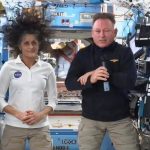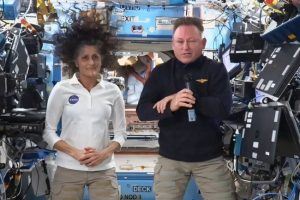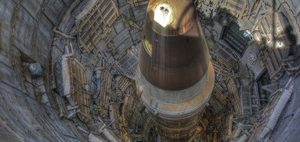When a severe drought hit the Indian city of Kozhikode, also known as Calicut, in 2016, residents, including student Swapnil Shrivastav, had access to a limited amount of water each day.
“We were rationed to two buckets of water a day, which we collected from water tanks,” he says.
While he says it is not uncommon for water supply issues to hit parts of India, it was a difficult month for Shrivastav and others in the region. “It was a very humid area; it was unmanageable.”
Shrivastav was already interested in water scarcity after winning a student competition in 2012 on how to imagine the future of water in cities, but the experience prompted him to explore solutions.
“One source of inspiration was Star Wars, where there is a device that turns air into water. I thought why don’t we try it? It was more of a curiosity project,” he says.
Several years later, in 2019, that idea led him, Govinda Balaji and Venkatesh Raja to create Uravu Labs, a startup based in Bengaluru.
Their system converts air into water using atmospheric water generators that contain a liquid desiccant that absorbs moisture from the air.
Using sunlight or renewable electricity, they heat the desiccant to 65°C, releasing moisture, which can then be condensed into drinking water.
Shrivastav says the entire process takes about 12 hours. Today each unit produces around 2,000 liters of drinking water.
However, while his vision was to provide clean water to communities facing water shortages, he says it was not financially viable.
“We realized that the technology still needs more time to grow and reduce its costs,” explains Shrivastav. “Or someone should fund it, but we haven’t found support in India.”
Instead, they currently sell the water to 40 hospitality customers, who in turn use it to provide drinking water to customers.
“We tried CSR departments [responsabilidad social empresarial] and non-profit organizations… but many companies avoid technology. They thought it wouldn’t work. We had to move to commercial consumer applications because they were willing to pay us and it is an element of sustainability for them,” he says.
Water scarcity is not new, but many countries, especially in the global south, are experiencing intense droughts and floods related to climate change that contaminate water sources.
More than 50% of the world’s population (4 billion people) experience water scarcity at least once a month, while by 2025, 1.8 billion people are expected to live in countries or regions with “absolute” water scarcity, according to the Food and Agriculture Organization of the United Nations (FAO).
Could atmospheric water generation technology be the answer? Thanks to its energy efficiency (it can run on renewable sources) it is a way to provide a source of fresh water without the need for traditional water infrastructure, making it an attractive option in remote locations.
There seems to be a market for the technology. Valued at US$3.4 billion in 2022, the atmospheric water generation market is expected to be worth US$13.5 billion in 2032, according to a report by Global Market Insights.
There are two main methods for generating atmospheric water. First, there is the cooling and condensation process that cools humid air to its dew point, causing water vapor to condense into liquid water.
The second is a desiccant-based system that uses hygroscopic materials to absorb moisture from the air and then release it through a heating process.
Through her social venture Majik Water, co-founder and CEO Beth Koigi manages around 40 atmospheric water generating units in arid and semi-arid regions of Kenya, using cooling and condensation-based techniques to capture moisture from the air.
Founded in 2017, Koigi was inspired to create Majik Water after first experiencing water shortages during a drought while studying in Nairobi in 2016.
While many visited a nearby river to fetch water for cooking, drinking and washing, Koigi says he dared not drink the contaminated water.
“It made me realize that we take for granted that water is always there,” he says.
He began looking for other water fountain ideas and created a water filter company before developing an air-water system.
Majik Water works with NGOs and humanitarian organizations, as well as being sold in stores.
Majik’s largest unit produces 500 liters of water in 24 hours and is installed in schools and small communities.
While there is demand for the system created by his company, Koigi does not see it as a permanent solution.
“Honestly, I think this is not the solution to water scarcity,” says Koigi. “It’s a temporary solution… especially because it’s not cheap.”
Manufacturers are focused on making air-to-water generation systems more energy efficient, says Avinash Singh, associate director of research and consulting at Global Market Insights.
“For example, innovations in compressors, heat exchangers and desiccants have improved the energy efficiency of such systems,” he notes.
He adds that government support, subsidies or environmental regulations could drive greater adoption of the technology.
One development that has helped the adoption of such water systems is the growing use of digital payments.
The Italy-based company Veragon has water production units in the Middle East, Asia, Africa and South America.
“When we originally started with off-grid communities, it was a cash-based partnership that wasn’t really viable… today it’s going digital,” says Veragon global business director Stephen White.
“For example, most of Cambodia is covered by [redes de telecomunicaciones] 4G and with covid-19 there was an explosion of electronic wallets. There are much better infrastructures and private partnerships: the government does not have to get involved and we sell water at a much lower price.”
He says all units will go digital in the coming months.
However, the prices of the units are not cheap. Veragon says its units, which use the refrigeration and condensation system, cost between $60,000 and $70,000.
But Shrivastav points out that producing water on site has a cost advantage as water is quite heavy and not easy to transport.
Looking ahead, Uravu Labs is exploring how advances in materials science can improve the efficiency of desiccants, or how using a different material to absorb more moisture from the air could make the process more effective.
Shrivastav says these advancements will also result in a reduction in required heat from 60°C to 40°C.
They also hope to run pilot projects that involve installing their units in data centers in India and Singapore.
Data centers generate a lot of heat that is normally lost, but Uravu plans to use it to generate fresh water.
“This process will result in a reduction of up to 95% in fresh water consumption [por parte del centro de datos]as the Uravu system captures most of the waste heat and returns cold water, so very little fresh water is needed,” says Srivastav.
Click here to read more stories from BBC News Mundo.
You can also follow us on YouTube, Instagram, TikTok, X, Facebook and our new WhatsApp channel, where you will find breaking news and our best content.
And remember that you can receive notifications in our app. Download the latest version and activate them.






![[Img #74676]](https://thelatestnews.world/wp-content/uploads/2024/12/Laser-artificial-neuron-150x150.jpg)






![[Img #74676]](https://thelatestnews.world/wp-content/uploads/2024/12/Laser-artificial-neuron-300x200.jpg)


Add Comment